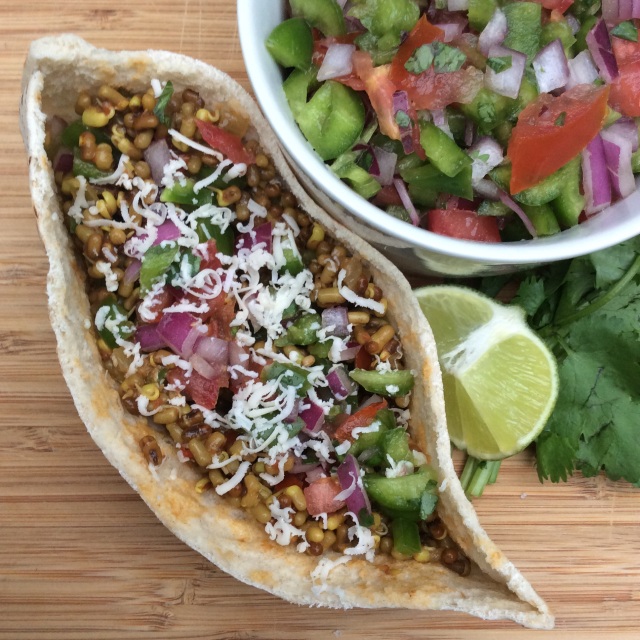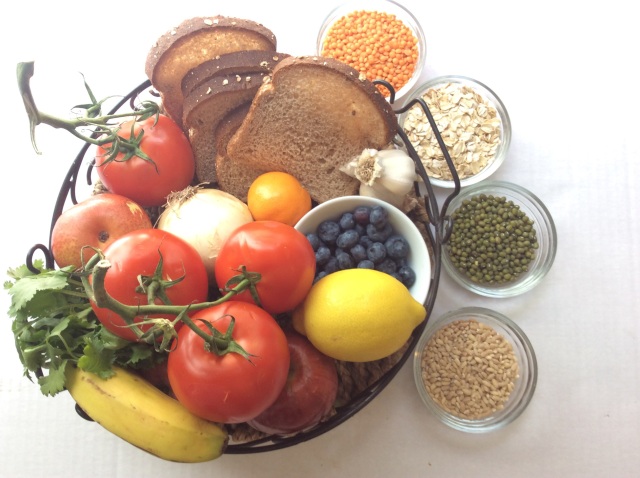That elusive weight goal!! Losing weight or switching to a healthier diet is often one of the most popular New Year’s resolutions, only to be abandoned for an enticing box of chocolates by the time Valentine’s Day rolls around. Which begs the question… why do so many of us (more than a third who have made a New Year’s resolution), throw in the towel about a month into the resolution?
One reason could be that these resolutions (likely made after one too many martinis on New Year’s Eve??-just kidding), are overly ambitious, not always realistic and specific steps to achieve the end goal are not always defined.
Given all this, I would like to leave you with six practical, doable steps to get into the pink of health in 2018.
- Complete meals count: Combine whole grains with lean protein and healthy fats to create complete meals (yes that includes breakfast too). This flies in the face of what our fat and carb-phobic popular culture has you believe, doesn’t it? However, we need all 3 macro-nutrients for the body to function optimally. While most folks have been “programmed” to understand the value of protein, carbs, even the healthful carbs continue to be the shunned, ugly, step children in the diet milieu. While we can, and should make a compelling argument against the ubiquitous refined carbs that line super market shelves today, epidemiological and clinical studies demonstrate that intake of dietary fiber and whole grain is inversely related to obesity, type 2 diabetes, and possibly cancer and cardiovascular disease. Likewise, we need a certain minimal amount of fats, primarily whole plant fats, for a variety of functions, but especially for satiety, or to prevent that all too familiar, after meal grazing.

An example of a “complete meal” with whole grains from the high fiber pita pocket, protein from the sprouted lentils and healthy fats from olive oil. © Copyright, 2015-2018, Sangeeta Pradhan, RD, LDN, CDE
- Make meat a condiment, not the main course: Avoid excess animal protein, and think twice before you guzzle down that protein shake or supplement. Our fat and carb-phobic society has over-rated proteins, putting them on a pedestal, much to the detriment of those who believe that message. Don’t get me wrong. Proteins serve important functions in the body, not the least of which is the repair and rebuilding of cells in the body, among other key functions. That said, unless protein needs are enhanced under special circumstances such as wound healing, most folks need approximately less than a gram for every kilogram of weight. In fact there is evidence showing that extra supplementation with protein is not necessary even in strength sports. However, according to a recent NHANES survey, Americans consume 1.5-to 2 times the RDA for protein. In addition to our society’s misplaced obsession with protein, our current higher protein consumption could also be chalked up to the increased calorie consumption from the abundance of calorie dense foods we have access to, today. Since protein is found in almost all foods in varying amounts, with scanter amounts in fruits, you can see how quickly and almost effortlessly you could meet, and in most cases exceed your RDA for protein, assuming your caloric intake is adequate. You don’t need to go meatless unless you choose to, but moving animal protein from center stage to condiment is recommended.
- Power up with plant power: Chock-full of nutrients and fiber, a plant based diet, unlike the western diet high in animal protein, has been associated with lower risk of chronic disease such as diabetes, heart disease, and with favorable changes in gut bacteria. As well, they promote increased sustainability and are much better for the environment. No wonder then that the plant based revolution is catching steam, and I would predict will only get stronger in the years to come. A varied intake of whole grains, legumes, nuts and seeds provide essential amino-acids, the building blocks of proteins, when consumed over the course of the entire day. For more information, please refer to the Academy of Nutrition and Dietetics’ position paper.
- If the ingredient list looks like a chemical cocktail, it belongs in a lab, not in your kitchen: Eliminate packaged foods with a list of ingredients so long they are falling off of the box…this speaks to our society’s obsession with convenience meals and pre-packaged foods, loaded with sodium and preservatives to extend their shelf life. Bear in mind that processed foods might range the gamut from minimally processed foods such as washed fruits or bagged salads which are acceptable, to frozen entrees and pot pies that are a far cry from the food in its native form, with questionable ingredients to boot. Of note, there is some emerging research in mice that shows a co-relation between dietary emulsifiers and alterations in gut microbiota, and subsequent low grade inflammation, colitis and the metabolic syndrome. So until we get to the bottom of this, experts recommend consuming foods in their natural form with recognizable ingredients.
- Listen to your gut instinct: As the gut microbiome emerges as the most exciting frontier in medicine today, we know that diets high in specific types of fiber called prebiotics allows the proliferation of probiotics or protective bacteria that are associated with good health. This solidifies the case in favor of plant based foods, but we can also boost the number of good bacteria in our GI tract by consuming fermented foods such as yogurt, kefir, kimchi, etc that contain live and active cultures of beneficial bacteria such as Lactobacillus or Bifidobacterium.
- Cook your way to good health: It must be pretty obvious by now that to truly seize control of all that goes in your mouth, we are at a disadvantage if we let others dictate our food choices. Cooking is the most effective way of ensuring that you know exactly what you are consuming. No, you don’t have to slave over a hot stove all day, or become a gourmet chef (although that would certainly not hurt), but try prepping a few items ahead of time so you are not tempted to pull into the local drive-thru, or pick up highly processed frozen entrees if you get stuck late at work. Here are a few ideas:
- Cook whole grains such as wild rice, farro, barley or quinoa with chicken broth and refrigerate.
- Toss arugula, spinach or romaine lettuce with leftover cooked chicken, cottage cheese tuna, or rinsed, canned beans for protein, throw in the precooked grains, for a quick fix week night meal
- Use make-ahead, one-pot complete, meals such as soups and stews that can be re-heated in a flash.

This chick-pea stew with quinoa is a great example of a complete meal all in one pot! © Copyright, 2015-2018, Sangeeta Pradhan, RD, LDN, CDE
- Scramble eggs with sauteed left over (or fresh veggies), sprinkle with cheese and your favorite dried herbs for a dash of flavor, and stuff into a high fiber pita pocket or wrap for a quick weekend brunch or week night meal.
- A baked vegetable and cheese fritata can also be made ahead of time, served with toasted whole grain bread and a side of fresh fruit to make a quick and satisfying dinner.

Chicken bean soup combines all 3 macro-nutrients and can be made ahead of time. © Copyright, 2015-2018, Sangeeta Pradhan, RD, LDN, CDE
As a parting thought, I always believe in “reaching for the low hanging fruit” as the saying goes. This is true with New Year’s resolutions too: pick 1-2 of the simplest, most achievable goals you can accomplish and give it all you’ve got! Once you have accomplished these smaller goals, you will build momentum, which will energize you to reach for the fruit higher up the proverbial tree-just make sure you do not reward yourself by gorging on that Valentine’s day chocolate on your way up:))!
A Happy and Healthy New Year to you all!
















































Great advice here. Luckily, almost all of our food is cooked from scratch.
LikeLiked by 1 person
Good for you, Peggy; that’s half the battle😊
LikeLiked by 1 person
Have a happy and healthy 2018!!
LikeLiked by 1 person
Thank you for stopping by! Best wishes for the New Year!
LikeLiked by 1 person
Thank you, Sangeeta for listing out these doable steps to get into the pink of health in 2018. Packaged food is an absolute No No. Any specific probiotics that you would recommend?
LikeLiked by 1 person
Hi Somali,
Thank you so much for stopping by. As I try to keep my blog free of commercial bias, I cannot recommend any specific probiotics as such, albeit I know Culturelle is pretty popular here. The important thing to note is whether the probiotic meets minimal criteria ( outlined below), as indiscriminate use of the term is common, and there is no “legal” definition for probiotics as such, hence consumers should be on the guard:
Here are a few of the important criteria to evaluate a probiotic:
1) Is the strain of the bacteria a purified strain, identified to the strain level?
2) Is the level the same that has been demonstrated in clinical studies to be effective?
3) Are the bacteria delivered in adequate amounts and are viable through the end of shelf life and is the product safe for target consumers?
4) Have they been shown in human studies to provide a health benefit?
There are often significant gaps for some products between the research and what the market place claims. Some products fail to meet label claims re: # and types of viable microbes and the quantity to be consumed for health benefits.
For more info, please visit these links:
Click to access dd1507669568e40f7de3a33641cc24fd4bd6.pdf
https://nccih.nih.gov/health/probiotics/introduction.htm
I hope this helps. Let me know if you have any other questions.
Happy & Healthy New Year!
Sangeeta
LikeLike
Wonderful and sage advice here Sangeeta. Wishing you a happy and healthy and peaceful New Year. 🙂
LikeLiked by 1 person
Thanks Debbie! Always great to hear from you:)). Take care.
LikeLiked by 1 person
You too. 🙂
LikeLiked by 1 person
Hokay!
LikeLiked by 1 person
Pingback: Massachusetts Academy of Nutrition and Dietetics - About MAND